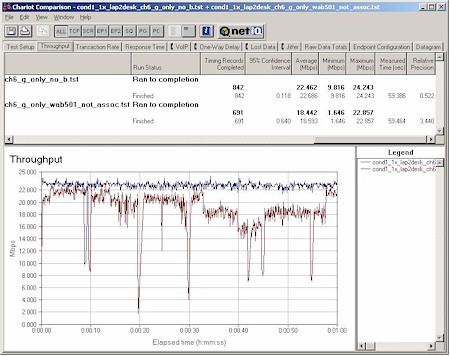What Doesn't Help
When faced with a wireless LAN that won't behave, people will try most anything in search of a cure. But some "solutions" don't really help and can actually hurt your (and your neighbors') WLANs performance. Let's look at some "solutions" commonly suggested:
Turning on WEP / Using authentication
Encryption methods such as WEP and WPA or using one of the many 802.1x authentication methods will keep unwanted clients from associating with your wireless LAN, but not from trying! Preventing association keeps clients from using significant amounts of your WLAN's bandwidth, but association attempts - especially in areas with many wireless clients - can still cause performance to degrade, particularly in slower 802.11b networks.Put another way, use of encryption doesn't do anything to the radio signal itself, but only to the information it is carrying. So while I recommend enabling WPA (or WEP if WPA isn't available) for security reasons, it doesn't do anything to reduce the effect of too many radios in too small a space.Turning off SSID broadcast
Although it's not the security precaution that some articles make it out to be, and it won't really help keep your clients from trying to associate with other wireless LANs, turning off the broadcast of your APs SSID could help your neighbor's clients to stay on their own WLAN. But again, change your default SSID, too, because if your neighbor's laptop detected and saved it in its "Preferred network" list at some point, it will still look for it during its association attempts.
- Selecting 11g-only mode
Owners of 802.11g equipment may have a few other knobs to fiddle with, depending on the products they have. Some 11g APs allow disabling of the 802.11b "Protection" mechanism that enables slower 11b clients to interoperate with faster 11g APs. Disabling "protection", however, is similar to enabling WEP or WPA in that the radio signal - and its negative effects - is still present. Shutting off protection, however, can have a larger negative performance effect on your WLAN than enabling WEP or WPA.

Figure 9: The effect of disabling 11b "protection"
(click on the image for a full-sized view)
Figure 9 shows throughput plots made with a Linksys WRT54G router and WPC54G CardBus card. Both traces were made with the pair set to 11g-only mode, i.e. "protection" disabled. The top trace shows throughput with no other clients in-range, while the bottom trace shows the effect of a single 11b client card just trying to associate with WRT54G - almost a 20% reduction in average throughput!
The amount of performance hit varies with many factors, but is so pronounced because turning off protection essentially turns off the coordination between 11b and 11g AP and clients. This raises the occurrence of transmit collisions and increases the probability that data will need to be retransmitted, lowering throughput.
TIP: For more on 11b protection, see the 802.11g NeedToKnow - Part 1.
Boosting your signal
As pointed out in the Wireless LAN Performance Improvement NTK, signal boosting solves at best half the problem since it can only help a client to "hear" an AP better and not vice-versa. Though I have to admit that boosting could help keep your client from straying by providing a stronger signal to latch onto, I would personally use this only as a last resort. Solving a problem by passing it on to someone else (your neighbor) isn't really a solution, in my opinion.
Using Super-G
Super-G's controversial "channel bonding" technique can cause severe problems in nearby WLANs under certain conditions (see the Atheros Super-G NeedToKnow - Part 1 for the details). But I put using Super-G for this purpose in the same category as signal boosting, i.e. not a real solution and something that may cause more problems than it solves.